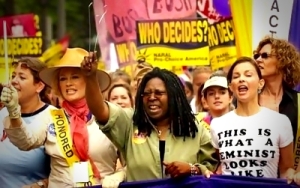Feminism has fought no wars. It has killed no opponents. It has set up no concentration camps, starved no enemies, practiced no cruelties. Its battles have been for education, for the vote, for better working conditions, for safety on the streets, for childcare, for social welfare, for rape crisis centers, women’s refuges, reform in the law. If some one says, “ Oh, I’m not a feminist”, I ask “Why? What’s your problem?” – Dale Spender, Man Made Language.
This is a strong statement as we looked at how sex and gender plays a pivotal role in shaping TV networks in programs in class. Michael O’Shaughnessy & Jane Stadler wrote about the feminist movement in their article, where they discussed the differences between sex and gender. They write that media texts are agents of socialization – carries of culture, ways of communicated ideology, a way to look at how we fit in the world that we see. Feminism plays a crucial role in defining how women are beginning to be portrayed in TV.
Gender/Gender Studies
O’Shaughnessy and Stadler talk about two key points under gender, biological essentialism (sex) and social construction (gender). Biological essentialism is gender based on physiological/psychological differences, whereas social construction is gender characteristics that are shaped by social exposure. Some see everything in the world is under constant construction, does something exist if its not named or defined? As we look to gender roles today, the roles between men and women are more blurred now than they were in the days of Donna Reed. This is partially due to how power is obtained and maintained to enforce or constrain these roles, also known as hegemony.
TV is a cultural depiction of gender roles. Something that is shown often enough – such as stereotypes – become the norm. When there is deviation, say Will’s role in Will & Grace as the not so stereotypical gay man, it becomes abnormal to see. This leads to the evolution of thinking, what now is normal or abnormal.
Oppositions help us in defining gender, and what we see as being masculine or feminine in TV.
Masculine – linked to profession – office job
Feminine – linked to domesticity – housewife
Which is then broken down into:
Rational – male trait – Doctors
Emotional – female trait – nurture
Activity – does things, moving
Passivity – stay at home
Subject – men as pursuers
Object – women as the object, what they are after.
Representation of Gender
Gender is often seen as political, you can’t define something without taking into consideration the world around the object. While we look to understand and define the role of women in texts, we must also define the role of men. See both sides of the coin. Here we look to ideological studies, gender studies, to see how culture shows the differences with male/female roles. One of the main things to look at is power, such as belief systems. In terms of religion, women are unable to hold positions like a priest, where in the judiciary system women are able to hold positions of judges, but it is not as common.
Feminism
First wave feminism – 1890s-1920s – This was crucial for moment for women. During this time the focus was on gaining the same citizenship/legal rights, and equal opportunities. At this point women gained the right to vote.
Second wave feminism – 1960s-1970s – Personal is political. This was where the tide turns for women’s activism. Women were struggling to define their role in the home and their sexuality.
Third wave feminism – 1980s-present – This present wave takes a look at revalidating the roles and differences between men and women. This new age feminism is being redefined by how women are choosing to express their sexuality. Bringing in the question, what and who is defined by feminism.
With in this context there is also a focus on youth/culture movements. This is a result from the progression of culture from the movements in prior years. Culture changes in increments – taking its time to develop and change.
Analyzing Texts
Creator identity – view/perspective – it is more collaborative, and looks for a common thread.
Contemporary TV – Today’s TV programs are hybrid genres, mixing the likes of a daytime soap opera with a drama filled cop show.
With the progression of where TV is going to where it has been, analyzing texts become more difficult. In image analysis, we look at how accurately images are positively/negatively represented. Which then leads to content analysis and looking at culture stereotypes – and how they are reduced to small defining characteristics, linking back to the positive/negative representation of images. Next is textual analysis, which does not stop at just the text, it is more complex. It takes a look at how everything is working together to ask better questions. Most critics will combine these methods, and shows that social construction becomes more important when looking at texts.
Identity: Individual > mass > Stereotypes – singularizes people’s thinking, but helps us understand more quickly, should be only taken in form of text.



